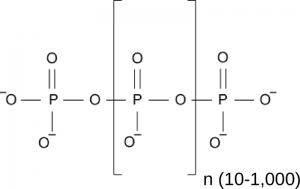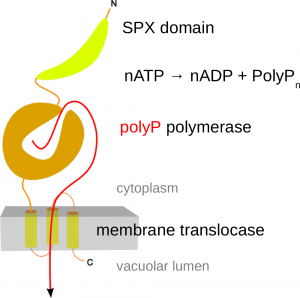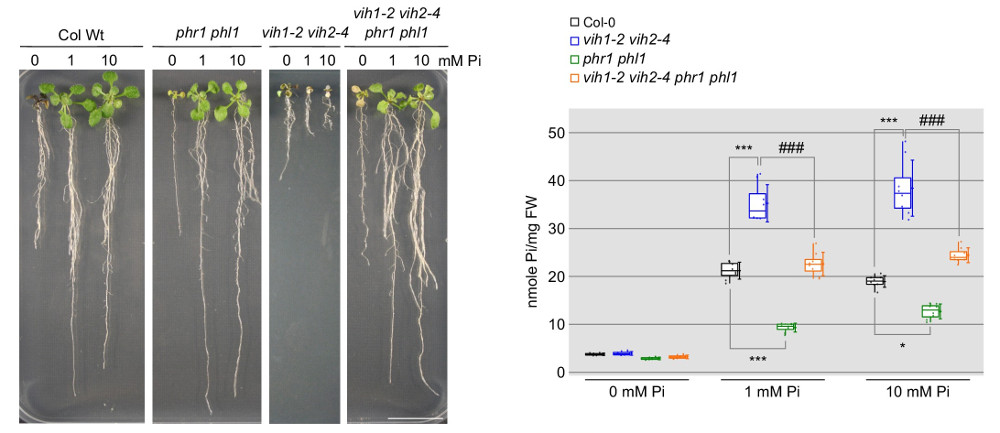Phosphate metabolism and signaling in plants
Life as we know it would not exist without phosphorus. It is a building block of DNA, lipids and proteins, and it represents the energy currency (in the form of ATP) of every living cell. All organisms have evolved sophisticated strategies to sense, acquire, transform and store phosphorus mostly in the form of inorganic phosphate. For plants, which obtain it directly from the soil, phosphate is a growth-limiting nutrient that is supplied in large amounts as fertilizer to satisfy the high-yield demands of modern agriculture. While progress has been made to understand phosphate starvation responses in plants, we still do not know how phosphate levels are actually ‘measured’. In our lab, we want to gain further insight into phosphate sensing, signaling and storage by studying different types of phosphate containing molecules, such as inorganic polyphosphates and inositol pyrophosphates (Lorenzo-Orts et al., New Phytol, 2020).
Inorganic polyphosphate – an ubiquitous but enigmatic phosphate polymer

One rather poorly understood storage form of inorganic phosphate in all pro- and eukaryotic cells is inorganic polyphosphate, a linear chain of orthophosphate units linked by phosphoanhydride bonds (Figure 1). In bacteria, polyP is generated from ATP by polyP kinase (Sylvie Kornberg, BBA, 1957) and serves important physiological roles (Kornberg et al., Ann Rev Biochem, 1999) . Inorganic polyphosphate kinases however are absent from eukaryotic genomes, and thus it was unknown for a long time how eukaryotes would synthesize inorganic polyphosphates.
A vacuolar integral membrane protein complex synthesizes polyP in yeast

Serendipity lead us to discover the first eukaryotic enzyme that would synthesize inorganic polyphosphate (Hothorn et al., Science, 2009). It turned out to be an integral membrane protein complex embedded in the vacuolar membrane, not a soluble enzyme. The so-called Vacuolar Transporter Chaperone (VTC) Complex (a nice name for “we don’t know what this protein is doing”) consists of at least three different subunits. All subunits have a transmembrane domain (see below). Two subunits (Vtc2/3 and 4) in addition have soluble portions, which face the yeast cytoplasm (Mueller et al., EMBO J, 2002) (Figure 2). Using X-ray protein crystallography, we could demonstrate that the soluble portions in VTC contain a tunnel-shaped triphosphate tunnel metalloenzyme (TTM) domain. We found that the Vtc4 TTM domain would bind and hydrolyze ATP in the presence of a manganese metal cofactor. After dialysing the tunnel domain in a solution containing ATP, we obtained crystals of Vtc4. To our surprise these crystals did not contain ATP bound in the catalytic cleft, but a long phosphate polymer (Figure 3) (Hothorn et al., Science, 2009)
.

VTC turned to be the long sought-for polyphosphate polymerase in yeast. Yeast cells contain high concentrations of polyphosphate in their vacuole. Point-mutations in the VTC transmembrane domain inhibit translocation of the polymer into this storage compartment. Upon inactivation of polyphosphate polymerisation in VTC, yeast mutants cannot survive under phosphate limiting conditions and have multiple cellular defects. We can thus speculate that inorganic polyphosphates are important storage forms of phosphate in eukaryotic cells. They may also play roles in ion homeostasis and energy metabolism.
The metabolism and cellular functions of polyphosphates in higher eukaryotes
The presence of inorganic polyphosphates has been well documented in bacteria, unicellular eukaryotes and animals. We are, however, still not certain of its existence in plants (Lorenzo-Orts et al., New Phytol, 2020). Unfortunately, the VTC complex is only conserved in unicellular eukaryotes and not present in plants (or in animals, for that matter). We thus aimed at identifying other polyphosphate metabolizing enzymes in the model plant Arabidopsis thaliana. We also tried to localize inorganic polyphosphates in plants and to understand their cellular and physiological functions. This work was supported by an ERC starting grant.
Arabidopsis contains AtTTM3, a soluble enzyme with structural homology to yeast Vtc4

We used a structure-guided approach to identify proteins in Arabidopsis with similarity to Vtc4. There are three TTM proteins present in the Arabidopsis genome (AtTTM1-3), with TTM3 being a small soluble enzyme with high structural similarity to Vtc4 (Martinez, Truffault & Hothorn, JBC, 2015). Postdoctoral fellow Jacobo Martinez-Font found however, that instead of polymerizing inorganic polyphosphate from ATP, AtTTM3 efficiently hydrolyzes short-chain polyphosphates in vitro. Why this discrepancy in catalytic activity between the yeast and plant enzymes? Jacobo dissected the catalytic mechanism of plant, yeast, bacterial and human TTM enzymes in mechanistic and structural detail. He found that most TTM enzymes hydrolyze their substrates using a two metal catalytic mechanism (Figure 4).

Vtc4 however, uses only one catalytic metal, with the second metal binding site modified in such a way, that it can harbor a phosphate polymer to which the ATP γ-phosphate can be transferred to (Martinez, Truffault & Hothorn, JBC, 2015). Jacobo’s work also allowed us to understand, how TTM enzymes can carry out such a wide array of enzymatic reactions (adenylate cyclase, thiamine triphosphatase, tripolyphosphatase etc. reactions have been reported): different TTM enzymes let their substrates enter from opposite sides of the tunnel domain. Thus, with the core catalytic center always remaining in the same location, TTM enzymes can generate either phosphate or pyrophosphate leaving groups (Figure 5).
Our characterization of AtTTM3 as a specific short-chain polyphosphatase conserved in the entire green lineage prompted us to investigate the physiological functions of the enzyme in Arabidopsis. Postdoctoral fellow Janika Witthoeft and PhD student Laura Lorenzo-Orts investigated ttm3 loss-of-function alleles that displayed strong phenotypes during embryo development. Laura then found that AtTMM3 is transcribed into a bicistronic mRNA that encodes for both AtTTM3 and the cell division protein 26 (CDC26) (Lorenzo-Orts et al., Nature Plants, 2019) (Figure 6). Not only did Laura identify an extremely rare eukaryotic bicistronic mRNA, she also discovered CDC26, which was thought to be absent in the green lineage. Laura established that CDC26 is in fact a subunit of the anaphase promoting complex/cyclosome (APC/C), and that AtTTM3 coordinates AtCDC26 translation by recruiting the transcript into polysomes (Lorenzo-Orts et al., Nature Plants, 2019). While there seems to be no biochemical connection between the two proteins, this bicistronic configuration is conserved across the plant lineage suggesting an important regulatory function.

CHAD domains are inorganic polyphosphate binding modules
Laura next identified other inorganic polyphosphate-related proteins in plants. Intriguingly, she found that in at least one plant, Ricinus communis, a CHAD-domain containing protein that shares high structural and sequence similarly to the CHAD domains present in bacteria and archae (Lorenzo‐Orts et al., Life Sci Alliance, 2019) (Figure 7).

Next Laura showed that CHAD domains specifically bind inorganic polyphosphates with high affinity and selectivity and solved a structure of a CHAD domain – polyP complex (Figure 8).

Taken together CHAD domains of previously unknown function are conserved inorganic polyphosphate binding modules present in the different kingdoms of life. Its singularity in the plant kingdom suggests that RcCHAD might have been acquired by Ricinus via horizontal gene transfer from a soil‐living bacterium. Whether it acquired a novel function or still binds inorganic polyphosphates in Ricinus remains to be investigated. We could exploit the inorganic polyphosphate binding specificity of CHAD domains to use them as probes for the detection of inorganic polyphosphates in plant cells. Notably, fluorescent protein fused CHAD domains localize to the nucleolus, suggesting that a inorganic polyphosphate store may exist in this subcellular compartment (Lorenzo‐Orts et al., Life Sci Alliance, 2019).
Detection methods for inorganic polyphosphates in plant cells and tissues
We complemented our search for bona fide inorganic polyphosphate binding- or metabolizing proteins in Arabidopsis by looking for stores of this enigmatic polymer in living plant cells and tissues. To this end postdoctoral fellow Jinsheng Zhu used a fluorescent dye (JC-D7), which specifically binds inorganic polyphosphate but not other phosphate-containing molecules, such as nucleic acids, nucleotides or phosphate salts (Angelova et al., ACS Chem Biol, 2014). While he was able to visualize inorganic polyphosphate granules in Arabidopsis cells expressing a bacterial inorganic polyphosphate kinase, he could not detect inorganic polyphosphates in wild‐type Arabidopsis plants, nor in other monocotyledonous or dicotyledonous plants (Figure 9) (Zhu et al., Plant J, 2019).
Taken together, we located inorganic polyphosphate binding proteins and metabolic enzymes in plants. However, we failed to detect significant inorganic polyphosphate stores in higher plants and could not define clear loss-of-function phenotypes for the inorganic polyphosphate phosphatase TTM3. This suggests that inorganic polyphosphates in plants either don’t exist or do not accumulate to high levels. They may only be present in specific cell types or organs, or may be produced in response to certain environmental stimuli not replicated in our in our plant growth chambers.

SPX domains are inositol pyrophosphate sensor domains controlling phosphate homeostasis in eukaryotic cells
In parallel to our analysis of plant inorganic polyphosphate metabolism, PhD student Rebekka Wild investigated the molecular functions of the N-terminal SPX domains in the VTC complex and in other eukaryotic proteins (Wild et al., Science, 2016). SPX domains are small, soluble domains found in fungi, plants and animals. They can exist as stand-alone modules but are often located at the N-termini of proteins involved in phosphate uptake, transport, storage, metabolism or signaling. We determined structures of fungal and human SPX domains from crystals obtained by carrier driven crystallization (Wild & Hothorn, Protein Science, 2016). The different structures revealed a new fold with two long a-helices, connected by linkers of variable size. These core helices and two smaller C-terminal helices together form a 3-helix bundle, which is preceded by an flexible N-terminal helical hairpin (Figure 10). Many invariant lysine residues, which represent sequence fingerprints for SPX domains, are clustered in proximity to the N-terminal hairpin structure. A combination of genetic and biochemical experiments in yeast and Arabidopsis by the groups of Andreas Mayer and Yves Poirier, University of Lausanne, revealed that this basic surface represents a docking platform for inositol pyrohosphosphates (PP-InsPs), signaling molecules with poorly characterized cellular functions (Figure 10).

The concentrations of PP-InsP are known to change in cells, depending on whether they are supplied with sufficient amounts of inorganic phosphate or whether they experience phosphate starvation. Rebekka could demonstrate that SPX domains, when bound to PP-InsPs can interact with other proteins. In plants, one such interaction partner is a transcription factor, which is switched on under phosphate starvation to induce expression of genes that allow the plant to respond to the lack of this important nutrient. Under normal growth conditions, when PP-InsP levels are high, the transcription factor is kept inactive by forming a PP-InsP-dependent complex with a plant SPX domain. Under phosphate starvation, the lack of PP-InsP leads to dissociation of the transcription factor – SPX domain complex, thereby enabling the transcription factor to transcribe its target genes. Taken together, Rebekkas work defines SPX domains as cellular receptor for PP-InsPs, which control phosphate uptake, transport, storage, metabolism and signaling in fungi, plants and animals.
Two bifunctional inositol pyrophosphate kinases/phosphatases regulate plant phosphate homeostasis
The next question to answer was obviously how these inositol pyrophosphate signaling molecules are generated in plants, and why the concentration of these molecules changes in response to phosphate availbility. Postdoctoral fellows Jinsheng Zhu and Kelvin Lau answered this question using a combination of plant genetics, cell biology and in vitro enzymology. Jin identified two homologous inositol pyrophosphate kinases/phosphatases VIH1 and 2 in Arabidopsis. (Zhu et al., eLife, 2019). Jin obtained double knock-out Arabidopsis mutants for the diphosphoinositol pentakisphosphate (InsP8) kinases VIH1 and 2.

These mutant plants display extreme developmental defects and die prematurely because they constitutively express phosphate-starvation genes and over-accumulate phosphate (Figure 11). Deletion of phosphate starvation response transcription factors (PHR) partially rescues vih1 vih2 mutant phenotypes (Figure 11), and places these two kinases in the plant phosphate signaling pathway.
Jin and Kelvin next found that VIH1/2 are bifunctional enzymes composed of a kinase domain that generates PP-InsPs and a phosphatase domain that degrades them. These activities are modulated according to the ATP concentration in vitro, while the phosphatase activity is inhibited by phosphate (Zhu et al., eLife, 2019). Thus, VIH1 and VIH2 are capable of translating fluctuations of cellular ATP and phosphate concentrations into changes in PP-InsP levels, allowing plants to monitor and maintain optimal phosphate levels.
SPX proteins target PHR transcription factors to control phosphate homeostasis
Stand-alone SPX proteins in Arabidopsis had been previously shown to interact with PHR transcription factors, which activate phosphate starvation gene expression when phosphate becomes limiting (Puga et al., PNAS, 2014). The newly-assigned PP-InsP sensor function prompted us to look into SPX-PHR interactions, which turned out to be strictly dependent on PP-InsPs, particularly InsP8 (Wild et al., Science, 2016, Ried et al., BioRxiv, 2019). PhD student Rebekka Wild determined crystal structures of the Arabidopsis PHR1 coiled-coil domain and identified residues required for the interaction with the PP-InsP bound SPX domain (Figure 11).

Postdoctoral fellow Martina Ried mutated these conserved interface residues and found that the mutations disrupted the interaction with the SPX receptor in vitro and in planta, resulting in constitutive phosphate starvation responses (Ried et al., Nature Comms, 2021).
Together with our work in VIH1/2, we conclude that InsP8 regulates plant phosphate homeostasis by controlling the oligomeric state and hence the promoter binding capability of PHRs via their SPX receptors. We conciliate the initial observations that SPX-PHR complexes are phosphate-dependent in planta by reasoning that under low phosphate conditions, VIH1/2 kinases are likely to deactivated causing a decline on PP-InsP levels that allows PHR transcription factors to bind to target promoters and activate phosphate response genes (Lorenzo-Orts et al., New Phytologist, 2020).
